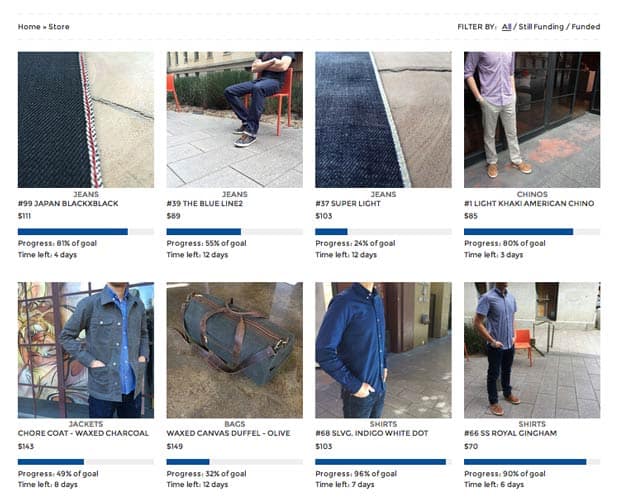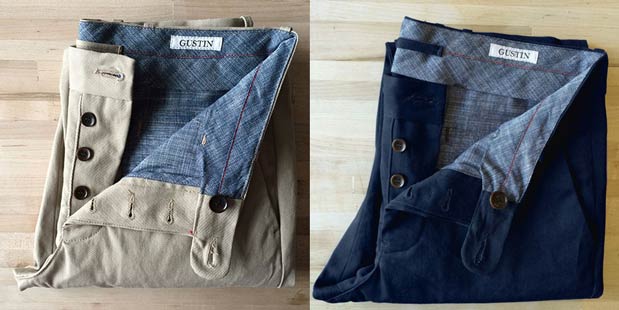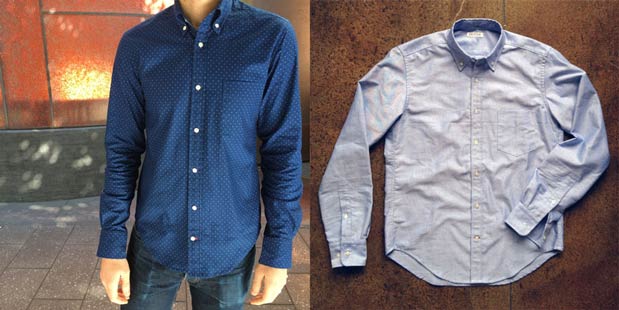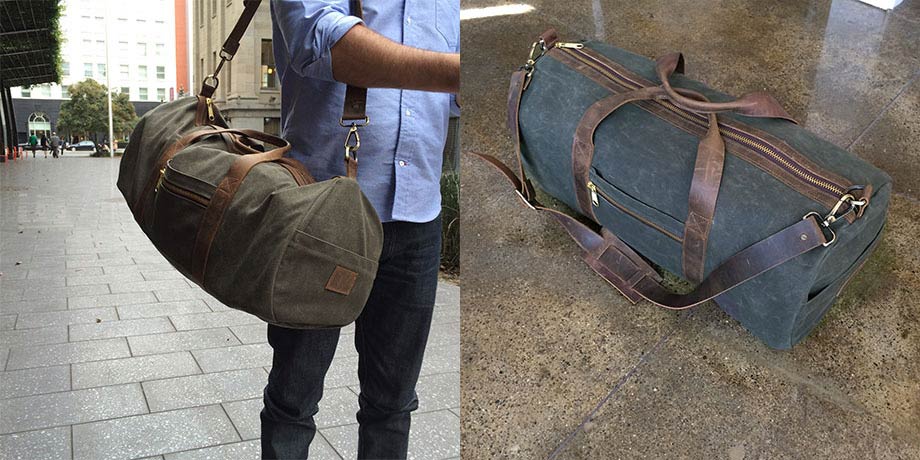After receiving his MBA from the University of California Berkley, Josh Gustin didn’t go into finance like most of his former classmates. Instead, he set out to do something completely unexpected: he wanted to make the perfect pair of jeans. A few years and several companies later, he launched his eponymous GUSTIN line in 2011, selling high-end denim in boutiques across America at upwards of $200. But he also grew increasingly frustrated with retail distribution, finding the timeframes unmanageable and the structure completely inefficient. He sought a new way to gauge supply and demand, and to get high quality goods directly into the hands of customers. Enter Kickstarter.
Looking to rebrand GUSTIN, Josh and his business partner took to the popular crowd-sourcing platform in 2013. Their pitch: a promise to produce high quality American-made jeans to be sold directly to customers at the wholesale price of $81. The campaign was a resounding success, raising nearly half a million dollars despite an initial goal of only $20,000. GUSTIN 2.0 was born.
Today, GUSTIN operates a simple e-store, carrying over the crowd-sourcing model that had made the Kickstarter campaign a sensation. So how does it all work? GUSTIN doesn’t carry any stock. Instead, they create a campaign for a particular item with a set campaign goal (e.g., a pair of jeans with a goal of 100 backers). Customers can then make a pledge, committing to purchase that item. If the number of backers reaches the campaign goal, the item is funded and it goes into production. Items that don’t secure enough backers aren’t produced.
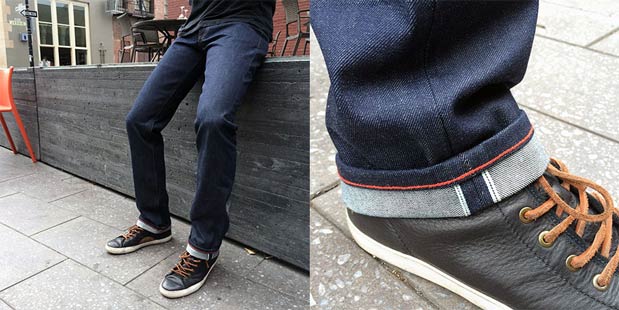 They’ve since built up their product line to include shirts, chinos, jackets, bags, and leather accessories, all of which are proudly made in San Francisco (coincidentally, the city where Levi Strauss made his name). They’ve also expanded their selection of fabrics, working with the finest mills across Japan, Europe, and America to secure a variety of interesting cloths like grey waxed cotton duck, Cone Mills bluexblack, and natural indigo plant-dyed selvedge. These more exotic offerings carry with them a small surcharge, though most jeans still hover around $100, and nothing sells for over $149.
They’ve since built up their product line to include shirts, chinos, jackets, bags, and leather accessories, all of which are proudly made in San Francisco (coincidentally, the city where Levi Strauss made his name). They’ve also expanded their selection of fabrics, working with the finest mills across Japan, Europe, and America to secure a variety of interesting cloths like grey waxed cotton duck, Cone Mills bluexblack, and natural indigo plant-dyed selvedge. These more exotic offerings carry with them a small surcharge, though most jeans still hover around $100, and nothing sells for over $149.
JEANS
GUSTIN’s bread and butter is jeans and for the price, which can range from $89 to a little north of $100, they certainly impress. All of GUSTIN’s hardware is custom made. Their metal buttons and rivets are branded, and their leather patches are cut and stamped in-house. With regard to construction, it’s the little things that highlight GUSTIN’s commitment to quality. Belt loops are tucked into the waistband and back pockets are half-lined, two details that complicate production but are done for added durability. The stitching is extremely clean with no loose threads, and the inseam utilizes a felled seam for a cleaner look.
All of GUSTIN’s jeans, regardless of fabric, come in a raw state, which means they haven’t undergone a treatment/wash at the factory. They’ll feel a bit stiff at first, but will soften with continued wear. Also, because the excess dye has not been washed off, your jeans will fade over time in a pattern unique to you. Most GUSTIN denim is sanforized (pre-shrunk) unless otherwise noted.
GUSTIN also focuses on selling jeans made with selvedge denim. Selvedge denim is woven on old-fashioned shuttle looms, which today have been largely replaced by machines optimized for speed production. Denim produced on shuttle looms often has a tighter and denser weave than denim made on modern looms, resulting in a fabric with far greater tensile strength. The word selvedge actually derives from the expression “self-edge,” which refers to the tightly bound edges found on both ends of shuttle loom-made fabric. This sort of finishing diminishes the likelihood of the edges coming undone.
CHINOS
Their recently introduced chinos are also worthy of note. The waistband is fully curtained using a lightweight chambray fabric, and the fly and seat seams are finished with indigo chambray binding. The belt loops are hand folded and tucked into the waistband (just like their jeans), and their pockets (slash pockets in the front and welt pockets in the back) are bar-tacked for added durability. Both the inseam and outseam use a busted seam for less bulk. The fabric is sourced from a mill in North Carolina known for its cotton twill.
GUSTIN offers their bottoms in two cuts: straight fit and slim fit. Because GUSTIN doesn’t operate a brick-and-mortar store where you can try on their clothes, they’ve created a detailed fit guide to make sure you get your order right (the same goes for all of their other items).
SHIRTS
GUSTIN’s shirts are another excellent value, and once again, the devil’s in the details. Single needle stitching, a superior method of construction beloved for its refined appearance and durability, is used throughout (it’s rarely found on cheaper mass market shirts). The front placket is pleated using a true two-piece construction, and the buttons are mother of pearl, not plastic. The shirt is cut with a more casual bias, with scooped out sides meant to look good when worn untucked. The higher-cut armholes assure a tailored appearance, and the attractive collar roll will look good done up with a tie or worn open. Couple that package with the high-quality fabric and all-American construction, and you get a value that can’t be beat (seriously, where else can you find a shirt like this for $76?).
JACKETS
If you like denim trucker jackets, then you’re going to love GUSTIN’s take on this American classic. The aesthetic is inspired by the longstanding Type III (introduced by Levi’s in 1962), but with a few custom upgrades. GUSTIN lengthened the sleeves and added two additional pockets – a small carry pocket on the right exterior and an inside chest pocket – for extra functionality. But the biggest difference is the fabric.
GUSTIN’s trucker comes in a mid-weight 13.5oz waxed cotton duck sourced from a mill right here in the States. This is a cloth that only gets better with age, each crease and abrasion creating a beautifully patinated canvas (read our piece on waxed cotton here). Past colors have included dark oak and olive.
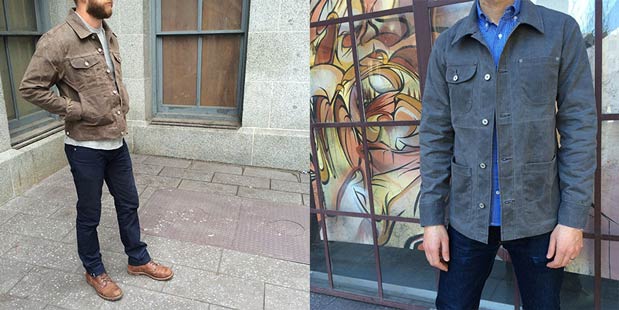
GUSTIN’s second jacket is an updated take on the chore coat. They borrow the basic silhouette of the trucker jacket, but lengthened it so it reaches halfway down the back pockets. Flat felling is used on the primary seams, with single needle construction on the pockets and bar-tacked corners for added durability. Fabrics include the aforementioned waxed cotton duck in a number of colors, as well un-waxed cottons for extra breathability.
ACCESSORIES
GUSTIN has also developed a line of accessories that includes belts, wallets, and a fantastic duffel bag. The belts are made with 12oz bridle leather in a variety of colors and finishes. The wallets, admittedly a bit crude in their finishing, are made from a number of different leathers, including hides from Chicago’s Horween.
The duffel bag is definitely one of my favorite GUSTIN offerings, made from 20oz waxed cotton, with full-grain leather trim and handles, and beefy YKK zippers. At $149, it’s one of the coolest bags on the market (others seem to agree, because it sells out almost immediately).
by Ilya Ryvin
You can follow Ilya on Instagram: @RyvinI









 Featured Videos
Featured Videos





